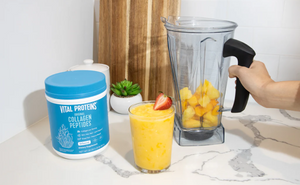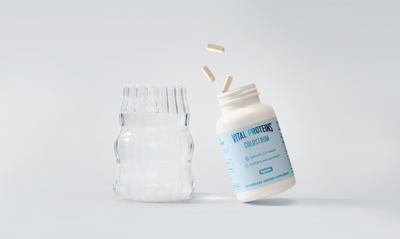Whether you're a fitness newbie or a total enthusiast, you've probably heard of resistance band workouts, which have gained popularity in recent years. A resistance band workout is a workout that incorporates — you guessed it — resistance bands for strength training, mobility work or therapeutic exercise. The bands are made of a flexible material and come in various styles and levels of resistance, ranging from 20 to 200 lbs. of resistance.
We enlisted the help of Jennifer Nagel, a certified personal trainer and Owner of Figured Out Fitness to share more about resistance band workouts. If you've been wondering if all the hype is the real deal, keep reading.
Vital Note: This article has been made available for informational and educational purposes only. It is not intended to be a substitute for professional medical advice, diagnosis, or treatment. Always seek the advice of your physician or another qualified health provider with any questions you may have regarding a medical condition. Your licensed healthcare professional can best provide you with the diagnosis and treatment of any medical condition and assist you as well in deciding whether a dietary supplement will be a helpful addition to your regimen.
Do resistance band workouts really work?
Resistance band workouts are not all hype. They really do work. "Strength training does not always require heavy barbells, dumbbells or machines," Nagel tells Lively. "Any type of external force on the body creates resistance and can help someone get stronger." This brings us to our next question.
Do resistance band workouts help build muscle?
Resistance bands can indeed help build muscle, but you need enough resistance to do so. "With strength training, the muscles get stronger and adapt to the load (resistance) applied over time, thus to build muscle, you need to periodically increase your load," Nagel says. "If you are a beginner, you can likely progress from bodyweight to light resistance bands to heavier resistance bands for progressive overload and to build muscle. However, at some point, you’ll likely either need to get a thicker set of resistance bands or use dumbbells or barbells to increase the load."

What are other benefits of doing resistance band workouts?
They're inexpensive. You don't need fancy exercise equipment to get a full-body workout when you have resistance bands. The best part is that they're more affordable than barbells or dumbbells. And, they're small and compact, making them easy to travel with.
They help improve mobility. "In addition to being used for building muscle and traditional strength training, resistance bands can be used to improve mobility because they help recruit stabilizing muscles," says Nagel. "This is beneficial for corrective and therapeutic exercise."
You have control over resistance. Another perk of resistance band workouts, Nagel says, is that you have more control over the resistance (compared to dumbbells or barbells).
Do resistance band workouts help you lose weight?
They can! Weight loss happens when a caloric deficit is created. "Most people create this deficit by a combination of eating below their maintenance calories and movement," Nagel says. "If you eat and exercise in such a way to create a caloric deficit, including working out with resistance bands, you will lose weight."

Are resistance bands better than weights?
One is not necessarily better than the other. It depends on your preference. Nagel recommends resistance bands for those who don't have access to weights or a gym and beginners as they are less intimidating. Experienced heavy lifters tend to prefer barbells and dumbbells because it is easier to create a larger external force. That said, Nagel notes that resistance bands are pretty powerful too and can provide up to 200 lbs. of resistance. Most resistance band sets, however, are usually between 20 and 50 lbs.
What strength resistance band should I get?
"If budget allows, I recommend having a set of resistance bands with handles, a set of mini bands to add additional resistance and stability work for the upper and lower body, and larger, thicker bands that can be used for movements such as assisted pull-ups or even to add additional resistance to dumbbell and barbell work," Nagel says.

What is the best resistance band workout?
There is no one "best" resistance band workout. But, as a rule of thumb, Nagel recommends full-body resistance band workouts over split workouts, where only one or two body parts are targeted at a time, as your best bet for getting the best resistance band workout possible and effectively working the entire body.
"Since more muscles are engaged, the heart rate increases, therefore, providing cardiovascular work while strength training," she says. "These exercises also tend to mimic normal everyday functional movement — like squatting to pick up a box and then lifting it overhead to a shelf — therefore making the exercises helpful for your workout and your everyday life."
If Nagel had to pick one resistance band exercise as the best, she'd go with the most comprehensive resistance band exercises, which are full-body, compound movements. "These are exercises that use multiple muscle groups, particularly large muscle groups," she explains. "I would recommend the resistance band squat to overhead press. The squat portion of the exercise engages the hamstrings, quadriceps, and glutes, while the overhead press portion of the exercise engages the shoulders and some of the back muscles. In addition, when performing the movement, the core is used to stabilize the body, thus providing core engagement."













